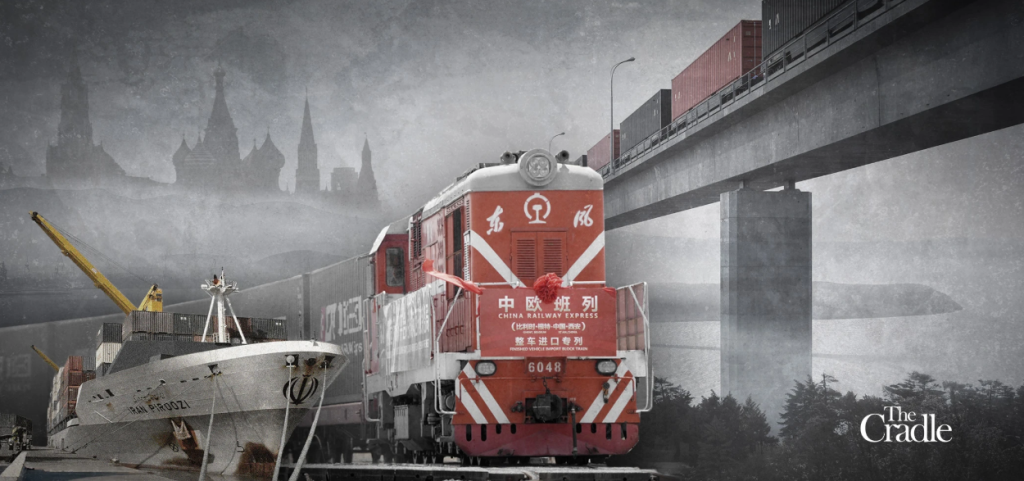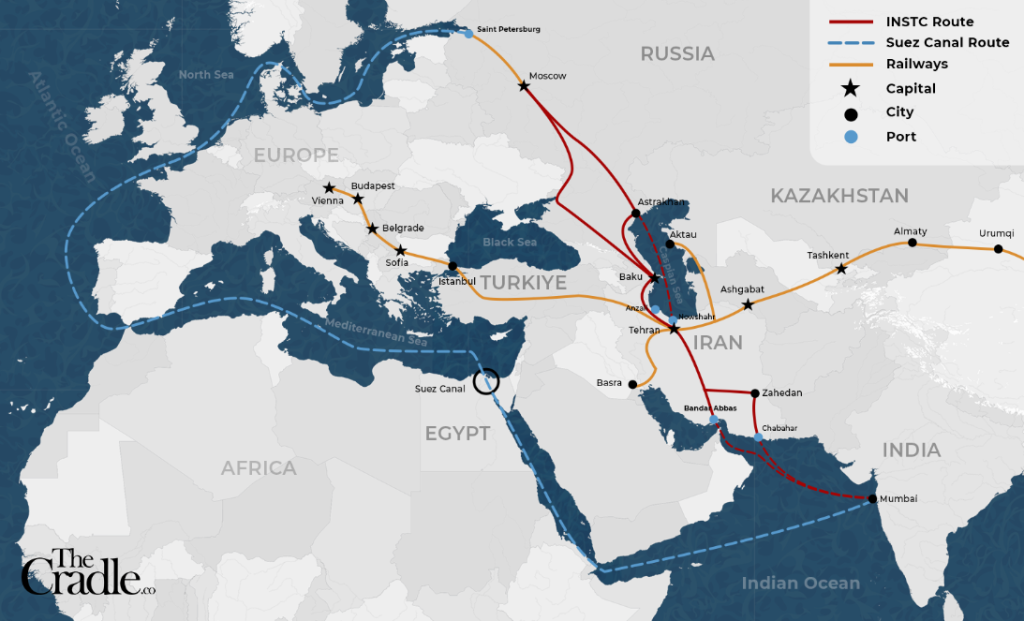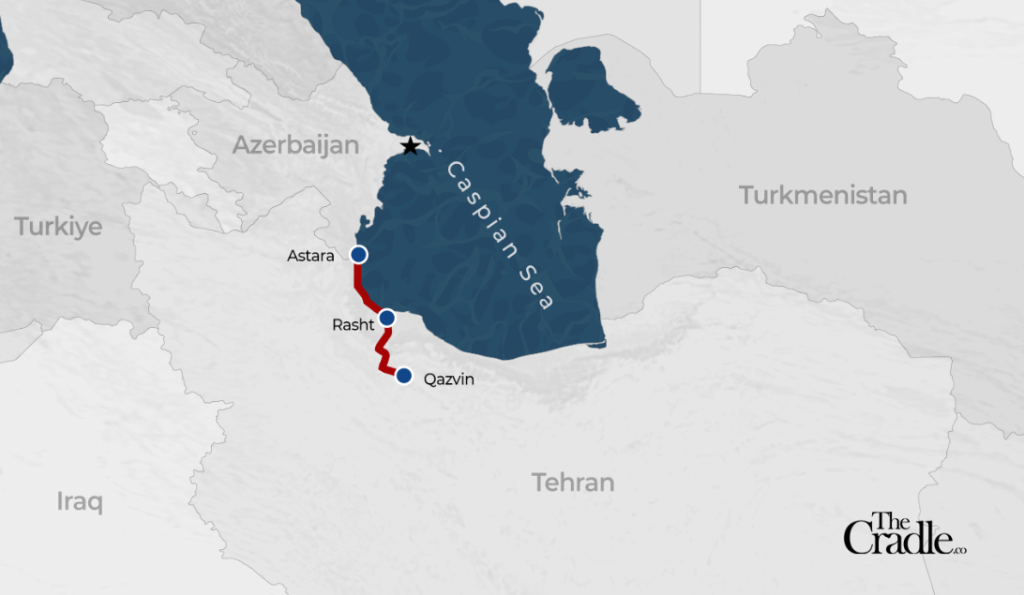Iran–Russia railway pact sets keystone in North–South Corridor
 by Vali Kaleji [11-7-2025].
by Vali Kaleji [11-7-2025].
Vali Kaleji is based in Tehran, Iran, holds a Ph.D. in Regional Studies, Central Asia and Caucasian Studies. He has published numerous analytical articles on Eurasian issues and Iran' foreign policy for Oxford Analytica in the UK, Eurasia Daily Monitor of Jamestown Foundation, Institute of Central Asia and the Caucasus (American Foreign Policy Council), the National Interest and the Middle East Institute in the United States, TRENDS Research & Advisory in the UAE, Middle East Council on Global Affairs in Doha, Qatar, and also Nikkei Asia.
Tehran and Moscow's long-delayed Rasht–Astara rail deal unlocks the final segment of a Eurasian freight artery, bolstering the Axis of Resistance and bypassing western sanctions.
In a long-anticipated development, Iran's Minister of Roads and Urban Development, Farzaneh Sadegh, announced on 26 October that a final contract with Russia for the construction of the Rasht–Astara Railway would be signed the following month.
This 164-kilometer line through Gilan province, hugging the southwestern Caspian Sea, marks the last missing segment in the International North–South Transport Corridor (INSTC) and is poised to radically transform Eurasian trade routes.
Beyond economics, the project also represents an effort to re-establish Iran’s rail connection with the South Caucasus for the first time in 35 years.
During the Soviet era, the Tabriz–Jolfa Railway, which connected to the Jolfa (Nakhichevan)–Meghri–Zangilan–Baku–Moscow line as well as the Jolfa–Nakhichevan–Yerevan route, was considered one of Iran’s main transit routes with the Soviet Union.
But the First Nagorno-Karabakh War in the 1990s ruptured the web of regional rail lines, isolating Nakhchivan and severing Iran’s decades-old railway link to the Caucasus.
Thirty-five years later, Iran reconnects to the Caucasus
Since the early 2000s, Tehran has explored multiple avenues to re-establish these lost links. A proposed Iran–Armenia route via Marand and Meghri never materialized. Efforts to revive the Soviet-era Jolfa–Nakhchivan–Zangilan line have stalled amid Yerevan and Baku’s ongoing dispute over the Zangezur corridor.
In contrast, the Rasht–Astara line, as part of the larger Qazvin–Rasht–Astara (Iran)–Astara (Azerbaijan) axis, is now the only active rail project linking Iran back to the Caucasus. It also extends further along the Astara–Baku–Dagestan route, reconnecting the Islamic Republic to a key segment of the Eurasian transport grid.
This idea is not new. The Soviet Union had extended its own railway network to Astara, Azerbaijan, in 1941, reaching the Iranian border. But within Iran, the crucial stretch from Astara to Qazvin remained incomplete.
Construction on the Rasht–Qazvin leg only began in 2009 and was completed a decade later, with an official launch in March 2019 attended by then-Iranian president Hassan Rouhani and Azerbaijan’s then-economy minister Shahin Mustafayev.
However, the construction of the Rasht–Astara Railway encountered significant challenges. A 2016 deal with the International Bank of Azerbaijan for a $500-million loan was shelved after US President Donald Trump – during his first term – unilaterally exited the Joint Comprehensive Plan of Action (JCPOA) in May 2018. Fearing US secondary sanctions, Baku froze its financial commitments.
Tehran subsequently turned to Moscow. When the late Iranian president Ebrahim Raisi visited Russia in January 2022, both sides finalized a $5-billion credit line to fund key Iranian infrastructure projects, including the Rasht–Astara Railway. Russia’s own trade needs had grown increasingly urgent under the weight of western sanctions, prompting Moscow to double down on the INSTC as a lifeline to India, Iran, and the Persian Gulf.
Russian Presidential Aide Igor Levitin, accompanied by Iranian railway officials, surveyed the route by helicopter in January 2023. Four months later, on 17 May, the two sides signed a $1.6-billion contract to complete the railway. Raisi presided over the ceremony in Tehran, with Russian President Vladimir Putin joining via video link.

Map of the International North–South Transport Corridor (INSTC).
Strategic rail link hinges on Russian capital and Iranian land
Despite the celebratory optics, the Rasht–Astara project faces formidable obstacles. The mountainous, forested, and ecologically fragile terrain in northern Iran presents serious engineering and environmental challenges. Specialized bridges, tunnels, and stabilization systems are required to navigate landslide-prone zones and protect sensitive ecosystems such as the Hyrcanian forests and regional wetlands.
Costs are steep. At an average of $10 million per kilometer, the entire line will cost an estimated $1.6 billion. Masoud Shakibaeifar, a transportation planning expert in Iran, believes that “the gross revenue of the project in this optimistic scenario could increase from $500 million in the first year of operation to $1 billion in subsequent years. In this case, a return on investment would be achievable within a 10-year period.”
But others, like Seyed Hossein Mirshafi, former infrastructure advisor to the Roads Ministry, argue Iranian contractors could complete the railway for under $700 million. It remains to be seen whether a new and different figure will be determined in the new Iran–Russia contract, which is set to be signed next month.
Land acquisition has been another sticking point. Much of the route runs through farmland, requiring time-consuming negotiations with private landowners. Under the current division of labor, Iran shoulders land procurement costs while Russia funds construction.
In this regard, Minister Sadegh stated: “Despite challenging climatic conditions and the constraints imposed by sanctions, approximately 80 kilometers of land along the route have so far been acquired and secured, and more than 30 kilometers have been handed over to the Russian side. We are prepared to transfer half of the route for the commencement of technical operations within the next few weeks.”
In addition, to overcome these challenges and mitigate environmental concerns in Iran, Hadi Haqshenas, the Governor of Gilan Province, announced that, following the emphasis of Iranian President Masoud Pezeshkian, the 160-kilometer Rasht–Astara route will be constructed on an elevated bridge.
These complexities make the Rasht–Astara Railway unlike any other infrastructure project in Iran’s recent history.

Map of Rasht-Astara Railway.
The North–South Corridor challenges Atlanticist chokeholds
The strategic weight of the Rasht–Astara line cannot be overstated. For Iran, under relentless sanctions, and for Russia, seeking alternatives to its embargoed European trade routes, the railway represents a crucial artery in the multipolar world order. It also restores Tehran’s long-lost rail link to the South Caucasus and, by extension, to Moscow and St. Petersburg. As such, it represents a major geoeconomic and geopolitical development.
Kamal Ebrahimi Kavori, a senior expert on Iran’s free trade and economic zones, believes that “the Rasht–Astara Railway project is not merely a simple rail line, but a vital artery linking Iran to major trade corridors – a route that connects the country’s northern and southern ports, free trade zones, and neighboring countries into an integrated and competitive transport chain.”
For Azerbaijan, which is not formally involved in the project, the completed rail link offers faster freight access to Pakistan – a key strategic ally – and the Persian Gulf Arab states. Given Baku’s expanding trade with these partners, the benefits are clear even without direct investment.
Currently, the lack of a direct rail connection at Astara means cargo has to be manually transferred between rail and road, clogging border terminals and slowing transit between Russia, Azerbaijan, and Iran. Once the Rasht–Astara line is operational, freight can move seamlessly from Russia’s northern cities to Iran’s southern port of Bandar Abbas.
An important point is that the North–South Corridor has three main routes: the eastern route (Central Asia), the central route (Caspian Sea), and the western route (South Caucasus). Although all three routes have gained significant momentum in recent years, particularly after the war in Ukraine and western sanctions on Russia, the main volume of transit and trade occurs along the western segment of the North–South Corridor, connecting India, Iran, Azerbaijan, and Russia.
Consequently, there is heavy truck traffic, especially at the Astara border terminals (Iran–Azerbaijan) and the Samur border terminal (Azerbaijan–Russia). Therefore, the construction and completion of the Rasht–Astara Railway could play a crucial role in reducing road congestion, lowering transportation costs, and accelerating transit and trade along this corridor.
In the first year of operation, the Rasht–Astara Railway is expected to handle up to approximately 10 million tons of cargo. In the long term, the cargo capacity of this route could reach approximately 15 million tons.
Adding momentum, Iran’s Preferential Trade Agreement with the Eurasian Economic Union (EAEU), signed in October 2019, became a Free Trade Agreement in May 2025. While Azerbaijan is not part of the EAEU, it remains central to the INSTC’s westward stretch. The Rasht–Astara Railway will thus help streamline trade between Iran and major Russian cities like Moscow and St. Petersburg.
Just days before the return of UN sanctions on Iran, Russia hosted a major nuclear deal with Iran on 24 September, and the two sides signed a $25-billion memorandum of understanding (MoU) to build four small-scale nuclear power plants in Sirik, in the southern Hormozgan Province. This was followed by the announcement of the Rasht–Astara Railway contract.
These moves signal a fundamental shift. Unlike in the 2006–2013 period when Russia backed UN sanctions against Iran, Moscow now stands aligned with Tehran against western coercion. Both reject the legitimacy of the UN snapback mechanism.
Far from being weakened by sanctions, the Iran–Russia partnership is expanding – anchored by energy cooperation, strategic transport corridors, and a shared challenge to western economic warfare.